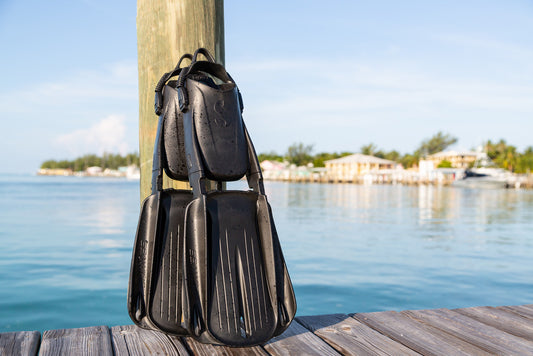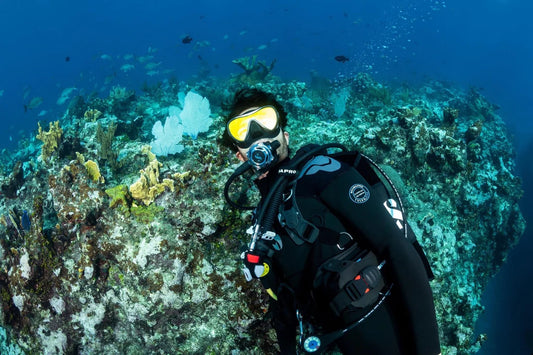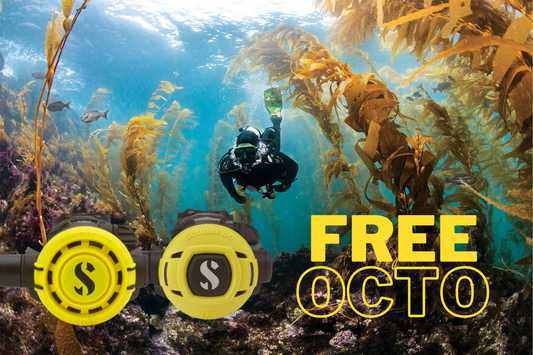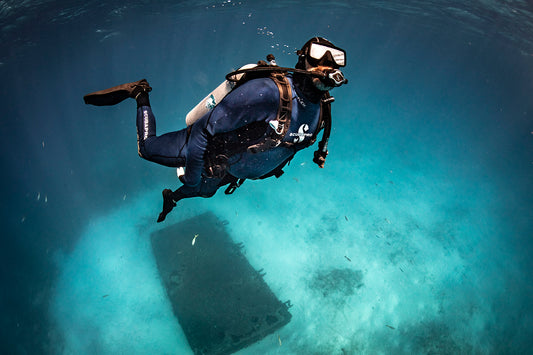
Neoprene drysuits are quite obviously made from neoprene of varying thicknesses and neoprene has some great advantages like it is flexible and stretchy which means that the suit can be a better fit and because neoprene is full of tiny little air bubbles it has its own thermal insulation value which reduces the need for additional thermal layers.
But as neoprene contains tiny air bubbles throughout the material it is subject to the effects of compression and expansion as the pressure changes. As a result, as you dive deeper the suit not only becomes thinner but also less buoyant which creates three problems:
- The weight you needed to sink at the surface is significantly more than you need at depth, potentially making you negatively buoyant and requiring a lot more lift to get you back up.
- A weight belt (or any other strap) tightened at the surface is now looser, adding the possibility of it slipping down or even off.
- The tiny air bubbles in the neoprene are shrunk, reducing the neoprene’s thermal rating.
In reality these are looking at the extreme but the effects and results are very real. So, how do we get around these problems?
Standard, Compressed or Crushed Neoprene
Neoprene drysuits don’t just come in standard neoprene though. You will also find versions using Compressed and Crushed neoprene which use different techniques to modify the material and help minimise some of the draw backs of neoprene.
Standard neoprene used in diving is essentially a foamed synthetic rubber that is then lined on either side to protect the neoprene and give a more durable finished surface.
Compressed neoprene goes through an extra process of pressurisation to simulate the effects of water pressure, reducing the material thickness, the air bubbles within and thus minimising buoyancy changes during the dive. The downside is that the material no longer has the same thermal efficiency it once did so you’ll need to compensate with additional thermal garments.
Crushed neoprene uses a different method to alter the neoprene but rather than using pressure to provide even distribution compression, the neoprene is crushed which squeezes the air bubbles and rubber out thinner. In compressed neoprene the cell structure and air bubbles are still round but in crushed neoprene the cells are flat which in theory makes the suit harder to penetrate and provides better stretch. Crushed neoprene has less buoyancy variation, is typically thinner than compressed neoprene but, again, the drawback is that the thermal efficiency is reduced. Crushed neoprene is also costlier to manufacture compared to compressed which will result in a more expensive drysuit.
Components
Seals
Typically, neoprene drysuits are fitted with neoprene seals as standard.
The wrist seals are simple cone shaped pieces that seal against the skin and are more comfortable than latex seals that are fitted to membrane drysuits as standard. Both latex seals and silicone ring systems can be fitted to neoprene suits.
A neoprene neck seal is a little different in the way they work compared to latex or silicone. Whilst it is the contact between the seal and the skin that creates the watertight barrier, the seal is folded over on itself and the air pressure within drysuit helps to keep the seal against the skin. Again, latex and silicone systems can be fitted.
In both the wrist and neck a neoprene seal is comfortable but they are known to divers to let a little water in so just be aware that if you get a little wet around the cuff or neck it is possibly not a leak and just an inherent issue with neoprene seals.
Zips
As with membrane drysuits the standard style of zip is a heavy-duty brass zip mounted across the back of the shoulders. There are no positional variations like with a membrane drysuit so you will always need another diver to help zip you up before the dive and let you out after.
There is nothing particularly wrong with a brass zip, it does the job and if properly maintained and cared for it should last a long time. There are, however, prone to damage if not respected or maintained. A brass zip is not very flexible by nature of its design so it bent the wrong way is can break, compromising its water integrity.
An alternative is a composite or plastic zip which are lighter, thinner and hugely more flexible than brass zips. Composite zips are becoming much more popular as aftermarket changes but are frequently found as an optional upgrade to customised and made to measures suits as well as standard on high end drysuits
Valves
Valve choice is the same as with membrane drysuits with a limited choice of trusted manufacturers. Inflator valves are either fixed or swivelling for convenience and better hose routing and dump valve come in cuff mounted, shoulder mounted auto or low profile shoulder mounted auto dump varieties.
A cuff dump allows manual control over your buoyancy by raising and lowering the appropriate arm but has problem of unavoidable dumping if the arm must be raised through necessity, maybe to carry out a task, grab a ladder or hold on a boat or in an emergency to grab a fellow diver.
The shoulder dump takes some of that away by automating the buoyancy process. The valve sensitivity can be adjusted during the dive by rotating the valve and as the pressure within the suit is reached the valve opens and vents enough air to close the valve again. The only thing you might find yourself doing is periodically rolling over slightly during ascents to make the valve the highest point for it to work properly. On the surface, it can be closed to prevent air loss and achieve positive buoyancy.
These days’ suits are typically fitted with swivelling inflator valves and low profile shoulder dumps as standard.
Boots / Socks
Off the peg neoprene drysuits will be available with either neoprene socks or heavy duty rubber boots whilst customised and made to measure will normally give you the choice.
Neoprene socks have the advantage of giving you control over the type of footwear you want with many divers opting for hardwearing canvas style boots that lace up at the front but you could also go for traditional neoprene boots as well.
Fitted heavy duty boots are usually made from thick rubber for excellent durability and often neoprene lined for thermal protection. The downside is that they are heavy and not particularly flexible.
Need Help Deciding?
Neoprene drysuits offer better thermal protection compared to a membrane drysuits but the problem is buoyancy and thermal variation as you dive. The suits come is a wide range is thicknesses for different water temperatures and dive durations as well different standard, compressed and crushed neoprene materials.
If you need help deciding which is the right drysuit for you please give us a call, send us an email, contact us via the website or come in and see us in store. If you would like to try on different suits and sizes please call us beforehand to arrange a time so that we can have a specialist ready and waiting for when you get here. If possible we can also have appropriate suits and size samples brought especially for you.




